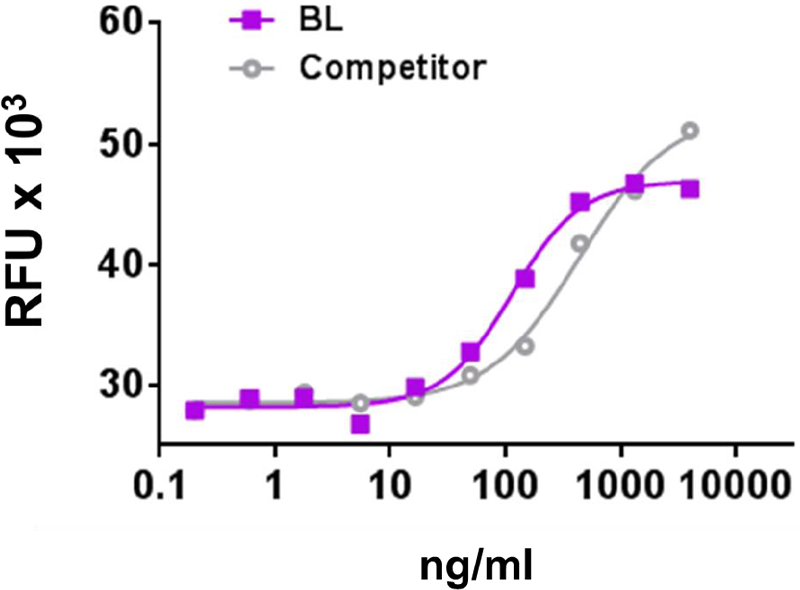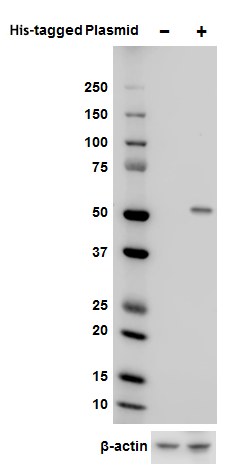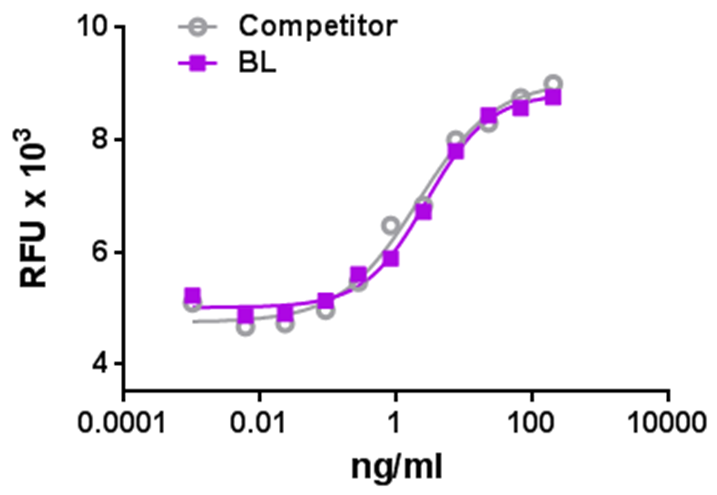- Regulatory Status
- RUO
- Other Names
- Heparin-binding EGF-like growth factor, HB-EGF-like growth factor
- Ave. Rating
- Submit a Review
- Product Citations
- publications

-

Recombinant human HB‐EGF induces proliferation of fetal mouse fibroblast cells, BALB/3T3 in a dose dependent manner. ED50 for this effect of 0.5 - 5.0 ng/mL.
| Cat # | Size | Price | Quantity Check Availability | Save | ||
|---|---|---|---|---|---|---|
| 552002 | 10 µg | $89 | ||||
| 552004 | 25 µg | $147 | ||||
Human HB-EGF was initially identified as a protein of 22 kD secreted by macrophage-like U937 cells. It belongs to the EGF family of proteins that includes EGF, TGF-α, heparin-binding EGF like-growth factor (HB-EGF), epigen, epiregulin, betacellulin, neuroregulin, and tomoregulin. All the EGF family members are synthesized as type I membrane protein precursors, which can undergo proteolytic cleavage at the plasma membrane to release a mature soluble ectodomain. It has been suggested that various metalloproteinases participate in the shedding of HB-EGF, such as MMP-3, MMP-7, ADAM9, ADAM10, ADAM12, and ADAM17. The ectodomain shedding is stimulated by phorbol esters, calcium ionophore, lysophosphatidic acid, and IL-1β. In addition, nardilysin, a metalloendopeptidase of the M16 family, binds HB-EGF and enhances its shedding through activation of TACE (ADAM17). The membrane-anchored HB-EGF acts in cell-cell and cell-extracellular matrix interactions; in addition, the membrane HB-EGF is the receptor for diphtheria toxin that can be internalized and induce apoptotic death. HB-EGF plays a crucial role in cardiac valvulogenesis; newborn knockout mice have malformed semilunar and atrioventricular heart valves and poorly differentiated lungs. HB-EGF is overexpressed in several types of cancer such as pancreatic carcinoma, ovarian cancer, and gastric carcinoma. Also, HB-EGF is involved in cancer metastasis and invasion of ovarian cancer, head and neck cancer, and thyroid carcinoma cells.
Product DetailsProduct Details
- Source
- Human HB-EGF-like growth factor, amino acids (Asp63-Leu148) (Accession# NM_001945), was expressed in E. coli.
- Molecular Mass
- The 86 amino acid recombinant protein has a predicted molecular mass of approximately 9.7 kD. The DTT-reduced and non-reduced protein migrate at approximately 13 kD and 16 kD respectively by SDS-PAGE. The predicted N-terminal amino acid is Asp.
- Purity
- >95%, as determined by Coomassie stained SDS-PAGE.
- Formulation
- 0.22 µm filtered protein solution is in PBS, pH 7.2.
- Endotoxin Level
- Less than 0.01 ng per µg cytokine as determined by the LAL method.
- Concentration
- 10 and 25 µg sizes are bottled at 100 µg/mL.
- Storage & Handling
- Unopened vial can be stored between 2°C and 8°C for up to 2 weeks, at -20°C for up to six months, or at -70°C or colder until the expiration date. For maximum results, quick spin vial prior to opening. The protein can be aliquoted and stored at -20°C or colder. Stock solutions can also be prepared at 50 - 100 µg/mL in appropriate sterile buffer, carrier protein such as 0.2 - 1% BSA or HSA can be added when preparing the stock solution. Aliquots can be stored between 2°C and 8°C for up to one week and stored at -20°C or colder for up to 3 months. Avoid repeated freeze/thaw cycles.
- Activity
- Recombinant human HB‐EGF induces proliferation of fetal mouse fibroblast cells, BALB/3T3 in a dose dependent manner. ED50 for this effect of 0.5 - 5.0 ng/mL.
- Application
-
Bioassay
- Application Notes
-
BioLegend carrier-free recombinant proteins provided in liquid format are shipped on blue-ice. Our comparison testing data indicates that when handled and stored as recommended, the liquid format has equal or better stability and shelf-life compared to commercially available lyophilized proteins after reconstitution. Our liquid proteins are verified in-house to maintain activity after shipping on blue ice and are backed by our 100% satisfaction guarantee. If you have any concerns, contact us at tech@biolegend.com.
Antigen Details
- Distribution
-
Monocytes, macrophages, T cells, neutrophils, eosinophils, myeloid leukemia blasts, myeloma cells, vascular smooth muscle cells, endothelial cells, and normal or neoplastic epithelial cells.
- Function
- HB-EGF is associated with proliferation and differentiation of stromal cells, apoptosis, and morphogenesis. It participates in inflamation, wound healing, atherosclerotic plaque progression, and cardiac valvulogenesis. TNF-α and IL-1β induces HB-EGF in endothelial cells.
- Interaction
- Fibroblast, smooth muscle cells, monocytes/macrophages, endothelial cells, astrocytes, keratinocytes, normal and neoplastic epithelial cells.
- Ligand/Receptor
- EGFR (ErbB1) and ErbB4; also binds to heparan-sulphate proteoglycans.
- Cell Type
- Embryonic Stem Cells, Hematopoietic stem and progenitors, Mesenchymal Stem Cells, Neural Stem Cells
- Biology Area
- Cell Biology, Neuroscience, Stem Cells, Synaptic Biology
- Molecular Family
- Cytokines/Chemokines, Growth Factors
- Antigen References
-
1. Higashiyama S, et al. 1991. Science 251:936.
2. Hirata M, et al. 2001. Biochem. Biophys. Res. Commun. 283:915.
3. Jackson LF, et al. 2003. EMBO J. 22:2704.
4. Nishi E, et al. 2006. J. Biol. Chem. 281:31164.
5. Yotsumoto F, et al. 2008. Biochem. Biophys. Res. Commun. 365:555.
6. Ota I, et al. 2013. Oncol Rep. 30:1593. - Gene ID
- 1839 View all products for this Gene ID
- UniProt
- View information about HB-EGF on UniProt.org
Related FAQs
- Why choose BioLegend recombinant proteins?
-
• Each lot of product is quality-tested for bioactivity as indicated on the data sheet.
• Greater than 95% Purity or higher, tested on every lot of product.
• 100% Satisfaction Guarantee for quality performance, stability, and consistency.
• Ready-to-use liquid format saves time and reduces challenges associated with reconstitution.
• Bulk and customization available. Contact us.
• Learn more about our Recombinant Proteins. - How does the activity of your recombinant proteins compare to competitors?
-
We quality control each and every lot of recombinant protein. Not only do we check its bioactivity, but we also compare it against other commercially available recombinant proteins. We make sure each recombinant protein’s activity is at least as good as or better than the competition’s. In order to provide you with the best possible product, we ensure that our testing process is rigorous and thorough. If you’re curious and eager to make the switch to BioLegend recombinants, contact your sales representative today!
- What is the specific activity or ED50 of my recombinant protein?
-
The specific activity range of the protein is indicated on the product datasheets. Because the exact activity values on a per unit basis can largely fluctuate depending on a number of factors, including the nature of the assay, cell density, age of cells/passage number, culture media used, and end user technique, the specific activity is best defined as a range and we guarantee the specific activity of all our lots will be within the range indicated on the datasheet. Please note this only applies to recombinants labeled for use in bioassays. ELISA standard recombinant proteins are not recommended for bioassay usage as they are not tested for these applications.
- Have your recombinants been tested for stability?
-
Our testing shows that the recombinant proteins are able to withstand room temperature for a week without losing activity. In addition the recombinant proteins were also found to withstand four cycles of freeze and thaw without losing activity.
- Does specific activity of a recombinant protein vary between lots?
-
Specific activity will vary for each lot and for the type of experiment that is done to validate it, but all passed lots will have activity within the established ED50 range for the product and we guarantee that our products will have lot-to-lot consistency. Please conduct an experiment-specific validation to find the optimal ED50 for your system.
- How do you convert activity as an ED50 in ng/ml to a specific activity in Units/mg?
-
Use formula Specific activity (Units/mg) = 10^6/ ED50 (ng/mL)
 Login/Register
Login/Register 














Follow Us